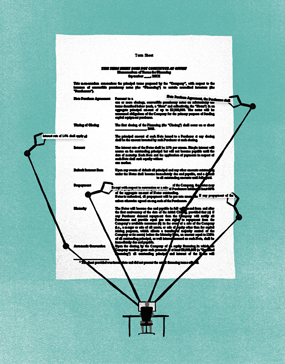Modern document automation goes beyond auto-fill. Coupled with artificial intelligence, this unstoppable force is poised to drive down legal costs and change the way lawyers practise
Stikeman Elliott LLP knew as soon as the provinces announced harmonized securities registration rules that it was the moment to pounce.
The firm had been flirting with automation software but just for its precedent library. Here, finally, was the business case to put it into action real-time.
“The practice group was fairly small, and we had a lot of clients in that space. We needed to help them navigate through all the changes and re-register them in the new category,” says Andrea Alliston, who oversees knowledge management in Toronto. “We had exactly the same issue across multiple offices. So to deal with the volume and make sure we were being consistent with our advice, we decided to use document assembly.”
Guess what? Six years later, Stikeman is still using automation for ongoing securities registration advice. It also uses it in areas that include real estate and derivatives.
Welcome to the new brave new world of corporate lawyering.
Computer systems today can generate everything from client reporting letters and multi-party cross-border loan agreements to complex term sheets and contracts — doing in seconds what it would have taken lawyers and paralegals days or weeks to complete. And this is just the dawn.
Some law firms have been quick to embrace it.
Go to Wilson Sonsini Goodrich & Rosati’s website and you’ll find a 47-page venture-financing term sheet generator. You fill in variables like the offering size, valuation, series of preferred stock, whether you want to issue warrants, number of shares, preferred stock rights, and redemption and anti-dilutive measures.
With the press of a button, you have a term sheet. And it’s free — a world not often associated with corporate legal advice. It makes you wonder why more in-house counsel aren’t clamouring for their outside law firms to use it to drive down what they spend on legal.
“It’s amazing stuff but it requires a significant investment and quite a lot of work to generate that amazingness,” says Alliston.
Ramping up takes a massive upfront investment of non-billable hours, with lawyers required to deconstruct hundreds, if not thousands, of legal documents in each area of the law where automation is going to be used.
Someone then has to code each part of each one to create the program. The systems also have to be continually updated and recoded where needed.
“If a new rule or decision changes the logic or adds a new variable or new language, or you need a new question in the questionnaire to make it appear when you need it, it’s quite a lot of work,” says Alliston. “It’s not for the faint of heart.”
That’s why some firms are not embracing document automation.
“We’re using one such software but very minimally,” says a partner who spoke on condition he and his law firm not be identified. “What we have found is that our paralegals struggle mightily trying to develop the appropriate ‘set-up’ to automate repetitive documents.
“At one point, we did have a specialist in the firm who could do this, but that person left. Our paralegals have generally ‘given up’ on using the software.”
Another lawyer speaking off the record says programming takes a lot of lawyer time that is “not rewarded. The billable-hour model makes it impossible to benefit from providing clients with easy-to-create contract precedents.”
Osler, Hoskin & Harcourt LLP has become one of the latest Canadian law firms to join the march towards automation. It recently assigned three people to do nothing but deconstruct documents and code as part of a pilot project testing two different software systems.
Mara Nickerson in Toronto, Osler’s Chief Knowledge Officer, says while the investment of non-billable time is daunting, “the imperative in the legal industry is to streamline our work and work more efficiently. So we’re looking for all opportunities where we can push work to a lower-cost resource or turn the work faster.”
As more and more legal work is done by automated systems, one thing seems clear: It is an unstoppable force that, hand-in-hand with artificial intelligence, over time, will sharply drive down legal costs.
In other words, events are no longer creating the perfect storm for automation. Turns out document automation is doing that all on its own.
For a sense of the potential impact on legal bills, take a plain-vanilla Ontario-based $100-million all-Canadian syndicated loan with one borrower, three guarantors and funds earmarked for general operating purposes.
A few years ago, the outside law firm would have used a couple of partners and two or three associates in the principal jurisdiction as well as a partner and one or two associates in each of the other provinces and territories. It would also require “heavy involvement” from the assistants, says Jonathan Dyck, a banking lawyer at Miller Thomson LLP in Toronto.
He estimates the client would have been billed for roughly 150 hours of legal work. Take an average of $400 an hour and that comes to $60,000 before disbursements and taxes.
That same transaction today, using automation, would involve one partner, one associate and one or two paralegals, Dyck says. He estimates it would generate 100 billable hours or less, putting the bill closer to $40,000.
Miller Thomson uses automated document systems in virtually every area from insolvency to banking, including M&A.
Dyck believes it’s just a matter of time before businesses bring documentation automation in-house, cutting their external lawyers out completely on small, recurring transactions that involve repetitive work.
The hold up is that in-house departments face the same up-front cost of setting it up as their outside law firms do.
“We did the loan and security documents for one of our clients and suggested to them that might be something worth looking at. The answer at that moment was: ‘It’s not the right time for us to make that kind of investment.’
“The software itself is relatively inexpensive depending on what you’re using — it’s just the time and effort of creating the templates you use that makes it such a big investment.”
But with their large legal departments and portfolios of repetitive work, Dyck sees banks and insurers – for generations a law firm’s prime clients – as prime candidates.
“Relatively straightforward transactions, small loan values, for example, one borrower, one guarantor in Ontario, a loan of, say, $4 million, they could automate the term sheet and prepare it themselves. I’m sure over time they’ll have it.”
Time is short. At least two of Canada’s big banks are said to be testing it and a third is reported to be in the procurement phase.
Where two or three banks go, its brethren financial institutions are not far behind. In-house departments everywhere should be watching.
Gowling WLG actively pitches its automation capabilities in areas like residential mortgages, mortgage enforcement and insurance defence work done for financial institutions.
Mark Tamminga in Hamilton, Ont., the firm’s leader of innovation initiatives, estimates it is something like 10 times more efficient than having actual human beings do the work. That means what once would have taken 20 billable hours may now take just two, and much of it can be done by lower-cost paralegals.
“We’ve pushed a tremendous amount of work down to the clerks. In each of these practices that we’ve automated, we’re able to fix-fee most of our work.
“Once you’re working with a fixed fee, the risk shifts back to the law firm. We’re not just selling hours, so who cares how much time we spend on it, now hours are a cost. We are in charge of our margin. As a cost, if I can increase my margin by automating these things, why wouldn’t I?”
Automation also cuts to the heart of risk management, Tamminga says. “Something as simple as entering in the numbers and then spelling it out in text in round brackets, who wants to type that multiple times? So you save yourself time but also enormously reduce your risk, your error potential. If a complex number appears 20 or 30 times in the document, you just want to grab it once and not enter it 20 or 30 times because, at some point, you’re going to make a mistake.”
Today’s automation is already more than auto-fill, he says, and uses logic. You enter the province and it uses applicable provincial requirements. It also does a lot of what used to be assistants’ work.
“It generates checklists, a reporting letter to the client that summarizes what we’ve done, who we’ve sent this to, when it expires, and as many envelopes as there are parties.
“You send that all as a single Word document to a multi-function printer and it will print up legal-sized legal documents, letter-sized letters, and the appropriate envelopes all in one print run. So the major job there is to stuff the envelopes.”
That’s a proposition that may involve just two people: The lawyer who collects the data and later signs off on the final documents and the paralegal who does all the data-entry work.
While Tamminga says it’s still “critically important the final document be blessed by a lawyer,” that doesn’t necessarily involve reading it. Instead, he says, he reviews the checklist to make sure all the data is correctly entered.
“If I’ve done the major legal blessing by signing off on the checklist, I have no problem signing the document itself. I don’t read the document through because we have a very high level of confidence in the form of the document, the critical point being is the variable information correct.”
Gowling WLG is so pleased with automation programs it’s working on a pilot program to push into new areas, including private placements.
Tamminga says a few years from now he can see legal departments regularly doing their own data entry over the Internet. Those using Gowling WLG automated systems may even be on a monthly subscription plan, he says, giving them access to the automated service and general advice in an online portal.
Twenty billable hours reduced to two client-subscribers? Automation technology is promising to be a complete disruptor of traditional law firm economics.
So why aren’t more general counsel demanding it?
Richard Stock in Toronto, the founding partner of Catalyst Consulting (and a Lexpert contributor), who advises in-house clients, says it is so new that many don’t realize what it can do or the impact it can have on their bottom line.
Stock says it’s the law firms that are actually taking the initiative in this area as they bid for competitive amounts of work. “I’ve seen law firms competing on their [automation] ability, saying: ‘We can do that better than our competitors without being asked,’” he says.
“Typically, the law firms volunteer this as a competitive edge and the client says: ‘Oh, we didn’t know about that. That’s really nice.’ It’s not the other way around. In this case it’s the firms pushing the capability rather than demand-side driven, with a few exceptions.”
Matthew Peters, National Leader, Markets, at McCarthy Tétrault LLP in Vancouver, seems fairly unenthusiastic about document automation. He says it’s not the case, it’s just that the firm doesn’t see automation alone as the Holy Grail because there are better ways to cut costs for clients.
“We worked on a system a number of years ago for the automation of certain corporate documents. With all the permutations and complexities that go into that, it was a huge investment. The need to have scale on that internally to recover your investment is so big that you just couldn’t get there. Then all of a sudden the rules would change so you had to redo all the logic.
“So we took a different view on it. We decided to treat the whole production of documents as a process and lean it out. Technology and automation is part of it, but quite frankly it’s a smaller part of it.”
What McCarthys does, he says, is build “a playbook” for each piece of work. It then uses offshore foreign-qualified lawyers, many South African, to prepare documents and work with the other side to revise them.
“If anything is outside the playbook they escalate up to us and at the end of the process we do a quality review to make sure a Canadian lawyer has ensured all the appropriate provisions are there and done properly.
“But you’ve taken out a whole bunch of the Canadian lawyer having to all the middle stuff. And offshore they’re using both automation tools, to some extent, and lower-cost labour to do the work as well. They’re efficient at it. They do it day in and day out.”
He believes automation can be based on a bloated pretext.
“We have a team that does a lot of capital markets work. Some of the legal work for financial institutions involves recurring transactions that can involve 15 different agreements documents that have to be finalized.
“So our team said: ‘What if we can consolidate those 15 documents down to something like five?’ That in and of itself substantially reduced the cost of doing the work. Our lending people said: ‘Why do we have all these different sorts of promissory notes that are all the same sort of idea? If we combine it into a single agreement, we can save a bunch of time.’
“Automation can be quite rigid. Anyone using automation alone is missing good opportunities. Our experience is there is a bunch of low-hanging fruit you can get to first, before you get to pure document automation.”
For the record, while the big banks may be flirting with in-house automation, Peters is not convinced they will eventually cut their outside law firm out of chunks of repetitive work.
“Instead of the banks having to assemble all this themselves, this is a big opportunity for law firms to leverage the scale that they have, and deliver a solution that will be more cost-effective than the bank doing it internally. That’s the way I believe it’s going.”
Nickerson of Osler sees it slightly differently. She expects in-house legal departments to build and use their own document automation programs for certain kinds of things.
Non-disclosure agreements are a perfect example, she says, because they’re fairly repetitive and widely used across different parts of the business.
While legal departments have traditionally collected the information and perhaps entered it in templates, she says they can now have the business side collect the information online and, at the very least, get a first draft to in-house counsel.
“I can see instances where an in-house legal group says to its business: ‘Here are the terms of our standard NDA. Fill in party names and you can have your agreement. If you need anything else, you still have to come to us.’
“It’s another manifestation of in-house groups growing their capabilities. I think the more they can standardize and use these tools, there may be things they no longer come to us for. That’s possible.”
But, like Peters, Nickerson doesn’t believe law firms will be replaced by in-house automation programs. “I think if firms build out their capability and service a wide variety of people, they may be able to do it more efficiently and provide it at a more efficient price than in-house can do. I’m not sure how that will play out — it could go either way.”
When automation meets artificial intelligence, that’s the real Big Bang for a new world for lawyers and law firms.
It’s already happening, Nickerson says, pointing to Berwin Leighton Paisner in the UK, which is using a “contract robot” in its real-estate group.
The robot extracts data from land registry documents and enters it into a spreadsheet. It cross-checks the data to remove duplicates and then uses the spreadsheet to send out queries and things like light-obstruction notices. The firm says the robot can complete legal work “within seconds,” which would take a team of paralegals and associates months to do.
“What we’re talking about today is just the beginning,” says Nickerson. “This is going to change how we practise, who does the work, and where the work is done.”
Nickerson believes it “could eventually change whether law firms become more purely advisory in some areas, versus doing some of that lower-end legal work.
“I don’t see it as disastrous for external counsel. I feel it’s a disaster if we don’t
do it.”
In-house Insight: Overcoming skepticism
External lawyers who use document automation sometimes face general counsel skeptical about its use. Here’s what some would like them to know about automation and what it can do for them:
It avoids repetition: “Almost every legal department has something it does that involves very repetitive requests from the business. It would be helpful for them not to have to keep reinventing the wheel and giving the advice again and again. So having something standard that the business can generate themselves to alleviate the workload on the legal department is a huge benefit,” says Andrea Alliston at Stikeman Elliott.
Let them demonstrate: “I usually offer a demonstration of how it works in my practice to show what it can do and how it can help them. People might think it won’t have a really positive impact on what they’re doing day by day. When they see it, they become a lot more enthusiastic and realize the benefits it could have for their organization,” says Jonathan Dyck at Miller Thomson.
It saves time: “One of the primary benefits is routinizing and commoditizing some of the straightforward documents that can take a lot of time between in-house counsel and the business. I’d think there’d be opportunities to look at some of the documents that the lawyers may spend a lot of time turning around – even if they have a model – and put some of that in the hands of the business with the right tool,” says Mara Nickerson at Osler, Hoskin & Harcourt.
It requires commitment: “These tools are very effective and they can save a great deal of time once you’ve got it right. But if you’re willing to do this, you’ve got to commit. Getting from here to there is still something, even in 2016, that you need to really grind down on. I’m not saying rah-rah, go for it, swallow your fear. I’m saying you have every reason to be worried about this. It isn’t like falling off a log. You need to commit to developing expertise. It’s a big project,” says Mark Tamminga at Gowling WLG.





